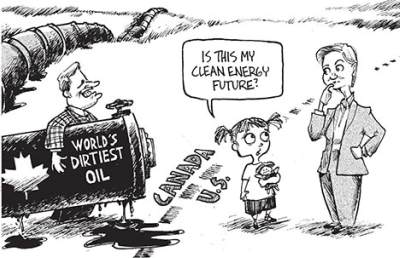 For many people this would be a no-brainer – but the billions being poured into dirty oil in Canada’s tar sands could be spent on clean energy instead to help decarbonise western economies. Or it could be spent on clean water to help the poor live.
For many people this would be a no-brainer – but the billions being poured into dirty oil in Canada’s tar sands could be spent on clean energy instead to help decarbonise western economies. Or it could be spent on clean water to help the poor live.
In their new report, the Co-op and WWF say the combined cost of all tar sands – $379 billion between now and 2025 – could be used for clean power projects such as the Desertec scheme linking solar plants in North Africa to a “supergrid” which could produce 15% of Europe’s electricity by 2050.
The money could also help half of the Millennium Development Goals in the 50 least developed countries, including averting four million child deaths annually and providing universal primary education.
These targets include averting the deaths of 4 million children, 300,000 mothers, and almost half a million victims of HIV and TB.
The report highlights Shell and BP’s involvement in tar sands investments. BP is set to invest $10 billion in its Sunrise tar sands project and also plans to spend another $2.5 billion converting a refinery in Toledo, Ohio, to process the synthetic crude oil produced from the tar sands. Meanwhile Shell is spending $14 billion to expand the Athabasca Oil Sands Project to raise its capacity to 255,000 barrels per day.
“The sums of money being invested in tar sands developments are enormous and difficult for the average person to grasp,” says Paul Monaghan, head of social goals at the Co-op.
He added that the report, called The Opportunity of the Tar Sands, “puts things into perspective and demonstrates not only the scale of the problem, which could take us to the brink of runaway climate change, but also the opportunity being lost. It is literally a matter of life and death that these enormous oil titans are re-steered to much more sustainable paths.”
The report is being released to coincide with the UK premiere of Dirty Oil, a hard-hitting documentary film that outlines the impact tar sands extraction is having on the environment and the health of first nation Indians. It is being distributed in 25 cinemas across the UK.
Narrated by Canadian actress and environmentalist Neve Campbell, the beautifully photographed documentary from the Academy Award Nominated director Leslie Iwerks tells the tar sands story through the eyes of scientists, industry officials, politicians, doctors, environmentalists and indigenous Cree Indians.
To see the trailer for Dirty Oil click here.

Why is it that most persons who advocate “clean energy” seem to have no real experience in the energy industry?
If you understand that 9 out of 10 dollars spent on wind or solar will end up rusting across the landscape before 20 years passes, you begin to understand the farce of “clean energy.”
The world needs real energy, not green garbage toxic rust.
It isn’t cheaper and producers now will not care if its sustainable, that can only matter when we use up other fuels.
Someone has to pick up the dead birds around those people windmills
It is very about market place research. Eco-friendly is a new buzz word. I am positive you can get marketing folks polling to find out which words catch the interest in the viewers. It is very a outstanding generic period which can mean anything at all without having offending just about anyone. If we say cleanse energy then most people may well say what about cleanse coal, which can be yet only a theory. If we say green that could possibly make persons believe of vast turbines or photo voltaic panels and several still guess these are too extravagant or ugly. Once you toss worldwide warming or environment change to the conversation, many will just tune out or begin a debate. So, “green” appears to be for being the safest option for now.
If this ideas will really help the future generation then in my own opinion it will be a good choice if this will be implemented but it must be implemented with unison to every body that has the knowledge in handling situations that will relate to this matter. it must be supported with every people that has the core knowledge in every aspect so that this will be efficiently process and completed succcessfully.